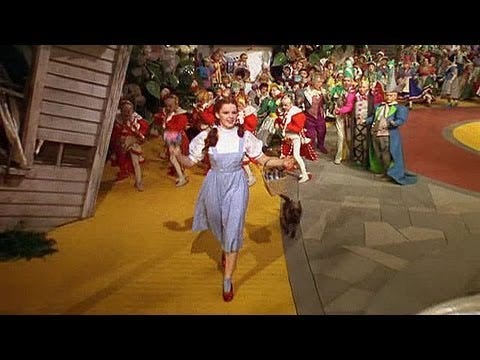Archetypes: The Wizard of Oz (Part Two)
In Part One of our analysis of The Wizard of Oz, we looked at the story’s primary characters and their respective narrative functions per these archetypes:
Protagonist — Dorothy Gale (Judy Garland)
Nemesis — Miss Gulch / Wicked Witch of the West (Margaret Hamilton)
Attractor — Hunk / Scarecrow (Ray Bolger), Hickory / Tin Man (Jack Haley), and Zeke / Cowardly Lion (Bert Lahr)
Mentor — Glinda (Billie Burke)
Trickster — Professor Marvel / The Doorman / The Guard Who Cries / The Carriage Driver / The Wizard of Oz (Frank Morgan)

In the External World (Plotline) of the story, once Dorothy reaches Oz, we can see how each of these characters plays their ‘role’ in relation to Dorothy’s Protagonist.
The Wicked Witch of the West provides persistent opposition to Dorothy:
- She threatens Dorothy when Dorothy has met up with Scarecrow and Tin Man, flinging a fireball (“Here, Scarecrow! Want to play ball?”).
- She creates a field of poison poppies causing Dorothy the Cowardly Lion to fall asleep.
- She writes “Surrender Dorothy or die!” in the sky over the Emerald City.
- She commands her winged monkeys to kidnap Dorothy in the Haunted Forest.
- She threatens to throw Toto into the river to drown in a vain attempt to get the ruby slippers from Dorothy.
- She sets a ‘ticking clock’ (hour glass) to determine the time when the Witch will kill Dorothy so the Witch can finally get the ruby slippers.
- She chases Dorothy and the others in the Witch’s castle when Scarecrow, Tin Man, and the Cowardly Lion sneak in to rescue Dorothy.

Scarecrow, Tin Man, and the Cowardly Lion provide Dorothy with emotional as well as tactical support:
- Scarecrow agrees to accompany Dorothy to see the Wizard, even when Dorothy warns him about the Witch being mad at her (“Witch? Huh! I’m not afraid of a witch!”).
- Scarecrow connives apples from the trees to feed a hungry Dorothy.
- Tin Man puts out the fire ball the Witch shoots at Scarecrow.
- When Dorothy and the Cowardly Lion fall asleep in the field of poison poppies, Scarecrow and Tin Man’s yells for help alert Glinda, who causes it to snow, which wakes up Dorothy and Cowardly Lion.
- They give comfort to each other when facing an angry Wizard of Oz.
- When Dorothy is kidnapped, Scarecrow, Tin Man, and the Cowardly Lion dress as the Witch’s guards and sneak their way into the Witch’s castle.
- Tin Man uses his axe to chop through the door in the room where Dorothy is trapped.
- Scarecrow uses Tin Man’s axe to chop down a candelabra which lands on a group of the Witch’s guards.
- After the Wizard has given a diploma to Scarecrow, a medal to the Cowardly Lion, and a heart to Tin Man, they all ask, “What about Dorothy”.

Glinda supports Dorothy with her wisdom:
- She uses her magical knowledge to cause snow to fall on Dorothy, Scarecrow, Tin Man, and the Cowardly Lion as they’re falling asleep in the field of poison poppies.
- She provides Dorothy with the special knowledge how to get back home (“And think to yourself — ‘There’s no place like home. There’s no place like home.’”).

The Doorman, the Guard Who Cries, and the Wizard of Oz (all played by actor Frank Morgan) provide a series of tests for Dorothy and the others:
- At first, the Doorman won’t let them in to see the Wizard.
- The Guard tells them in no uncertain terms that “nobody can see the great Oz!” until Dorothy talks about Auntie Em, causing the Guard to cry.
- The Wizard gives the group a small task — “Bring me the broomstick of the Witch of the West.”
- Once Dorothy and the others return with the Witch’s broomstick, the Wizard tries to trick them by telling them to “come back tomorrow.”
- Revealed from behind the curtain, the Wizard ‘shapeshifts’ from a threatening figure into a benefactor, giving Scarecrow a college diploma, the Cowardly Lion a medal, and Tin Man a heart.
- The same ‘shapeshift’ occurs with Dorothy for instead of opposing her, the Wizard offers to take Dorothy back to Kansas in his balloon.

Let’s not forget Toto who helps Dorothy (escaping from the Witch, finding the others and leading them back to the Witch’s castle; pulling back the curtain to reveal the real Wizard) and hinders Dorothy (leaps out of her arms to chase a cat, causing her to miss flying away in the balloon with the Wizard), actions befitting a Trickster character.

So we see the myriad of instances in which each of these primary characters — in the External World through actions and words — impact the Plotline in ways concurrent with their respective narrative functions. But what about the Themeline, the emotional and psychological arc of the story’s Internal World?
In The Wizard of Oz, as in virtually every movie, the Themeline is tied to the Protagonist’s transformation. Dorothy’s goal is tied to the idea of home: In the External World (Plotline), she wants to get back home — she states that over and over again once she gets to Oz:
DOROTHY
Oh, I'd give anything to get out of Oz
altogether -- but which is the way back to
Kansas?—
SCARECROW
Did you hear that? He'll announce us at
once! I've as good as got my brain!
TIN MAN
I can fairly hear my heart beating!
DOROTHY
I'll be home in time for supper!—
SCARECROW
Looks like we came a long way for nothing.
DOROTHY
Oh -- and I was so happy! I thought I was
on my way home!—
DOROTHY
I -- I'm here in Oz, Auntie Em. I'm locked
up in the Witch's castle....and I'm trying
to get home to you, Auntie Em! Oh, Auntie
Em, don't go away! I'm frightened! Come
back! Come back!—
DOROTHY
Tomorrow? Oh, but I want to go home now.But as we noted in the previous post, Dorothy needs to feel like her home in Kansas is her home. Where she begins her transformation-journey is a place of alienation, an orphaned child living among adults, dreaming of a place “over the rainbow” where she could feel a sense of belonging. Look at what she says about living with her aunt and uncle on that Kansas farm in the story’s Act One set-up:
DOROTHY
Nobody cares about me at home. They wouldn't
even miss me.But once Dorothy has traveled to Oz and had several experiences there, she realizes something:
DOROTHY
Auntie Em was so good to me -- and I never
appreciated it. Running away -- and hurting
her feelings.So in one sense, Dorothy’s journey to Oz helps provide her with a perspective where she can begin to appreciate what she had back home. But I think something else happens to help transform her feelings, not just some intellectual or logical understanding that “I never appreciated it,” but an emotional connection to her home back in Kansas: And I assert that this occurs in her deepening relationship with Scarecrow, Tin Man, and the Cowardly Lion and the people in her ‘real’ life they represent — Hunk, Hickory, and Zeke. For it is with these three characters — these three Attractor types — that Dorothy spends most of the story. She begins each relationship as a stranger to them, but through their collective efforts facing tests and trials, and overcoming obstacles and reversals, they bond into true friends as witnessed by their interactions and Dorothy’s comments as she is about to go back home to Kansas:
DOROTHY
Oh, dear -- that's too wonderful to be true!
Oh, it's -- it's going to be so hard to say
goodbye. I love you all, too. Goodbye, Tin
Man. Oh, don't cry. You'll rust so
dreadfully. Here -- here's your oil-can.
Goodbye.
TIN MAN
Now I know I've got a heart -- 'cause it's
breaking.
DOROTHY
Oh -- Goodbye, Lion. You know, I know it
isn't right, but I'm going to miss the way
you used to holler for help before you found
your courage.
LION
Well -- I would never've found it if it
hadn't been for you.
DOROTHY
I think I'll miss you most of allAnd this theme of friendship is echoed when Dorothy wakes up back in Kansas and sees Hunk, Hickory, and Zeke in her bedroom:
DOROTHY
Oh, you're the best friends anybody ever
had! And it's funny, but I feel as if I've
known you all the time. But I couldn't
have, could I?So the journey to Oz allows Dorothy to get the intellectual awareness of how much Auntie Em has done for her, but it is through the bonding experiences with Scarecrow, Tin Man, and the Cowardly Lion that she comes to a deeper emotional understanding — these three are her friends and because of these newfound friendships, she discovers a sense of belonging, fulfilling her need that her home in Kansas is truly a home. As Dorothy expresses in the very last lines of the movie:
DOROTHY
Home! And this is my room -- and you're
all here! And I'm not going to leave here
ever, ever again, because I love you all!
And -- Oh, Auntie Em -- there's no place
like home!In summation, The Wizard of Oz is an excellent example of five primary character archetypes — Protagonist, Nemesis, Attractor, Mentor, Trickster. The functions of the latter four service both the physical and psychological journey of the Protagonist, so when Dorothy returns home, she is a transformed individual.

